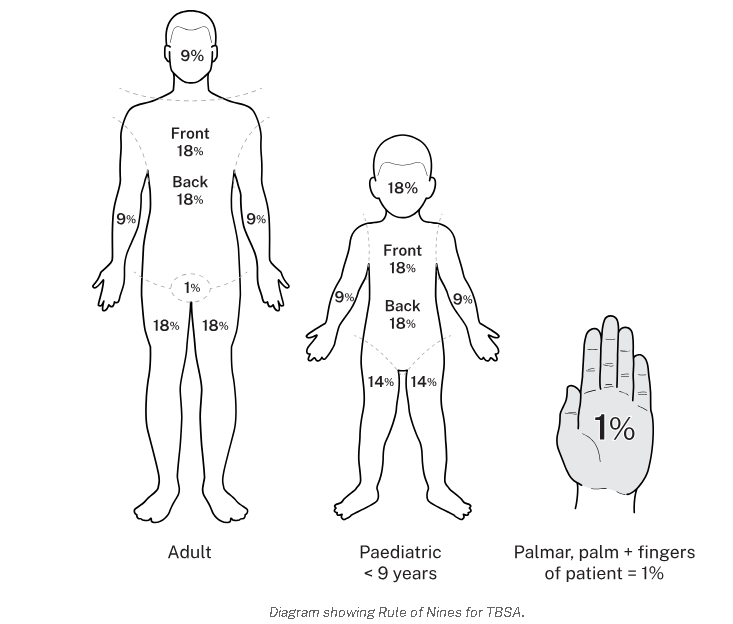Estimate burn area
The extent of injury is best described using the percentage of the total body surface area (%TBSA) that is affected by a burn.

The measurement of burn surface area is important during the initial management of people with burns for estimating fluid requirements and determining need for transfer to a burns service.
Three ways to calculate TBSA
The following are methods of assessing TBSA percentage. Ensure the method is adjusted for adults or children.

Rule of Nine
For adults, a “Rule of Nines” chart is widely used to determine the percentage of total body surface area (TBSA) that has been burnt. This chart divides the body into regions that represent approximately 9% of the total body surface area (TBSA). It's commonly used in adults, with specific percentages allocated to areas like the head and neck, limbs, and trunk. By assessing the percentage of burn injury in each region and summing them, the total TBSA can be determined.
Palmar Method
Uses the palmar surface of a patient’s own hand, spanning from the distal wrist crease to the closed tips of all five digits, is equal to 1% of (TBSA).
Additonal considerations
- For severe burn injuries (>50%TBSA) it may be easier to calculate what isn’t burnt then subtract it from 100 to get % TBSA burns
- For pre-hospital and emergency department settings, the % TBSA burns is more important than the depth of burn. % TBSA burns has indications for severity of injury, fluid resuscitation and transfer destination. Depth of burn becomes more significant after arrival at the Burn Service as depth of burn will determine whether the burn can heal without surgical intervention, and how the Burn Service will subsequently manage it.
- If % TBSA burn estimation is inaccurate it has the potential to negatively impact fluid resuscitation by providing too much or too little fluid. Always titrate fluid resuscitation volumes according to resuscitation end points. Urine output is a simple and easy method to assess perfusion
- For overweight patients, the contribution of various body segments to the total body surface area (TBSA) changes, but there's no universally agreed-upon adjustment for this population. Close clinical assessment by a Burn Service is necessary to accurately estimate TBSA, considering factors like body weight and proportions.
Complete your burns assessment
Burn % TBSA and burn depth are both required for a complete burn assessment. If you have your total body surface area calculation, be sure to also assess burn depth.
